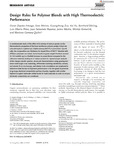Design Rules for Polymer Blends with High Thermoelectric Performance

View/
Use this link to cite
http://hdl.handle.net/2183/31051
Except where otherwise noted, this item's license is described as Atribución 4.0 International (CC BY 4.0)
Collections
- Investigación (EPEF) [590]
Metadata
Show full item recordTitle
Design Rules for Polymer Blends with High Thermoelectric PerformanceAuthor(s)
Date
2022-04-07Citation
Zapata-Arteaga, O., Marina, S., Zuo, G., Xu, K., Dörling, B., Pérez, L. A., Reparaz, J. S., Martín, J., Kemerink, M., Campoy-Quiles, M., Design Rules for Polymer Blends with High Thermoelectric Performance. Adv. Energy Mater. 2022, 12, 2104076. https://doi.org/10.1002/aenm.202104076
Abstract
[Abstract] A combinatorial study of the effect of in-mixing of various guests on the
thermoelectric properties of the host workhorse polymer poly[2,5-bis(3-tetradecylthiophen-
2-yl)thieno[3,2-b]thiophene] (PBTTT) is presented. Specifically, the composition and thickness for doped films of PBTTT blended with different polymers are varied. Some blends at guest weight fractions around 10–15% exhibit up to a fivefold increase in power factor compared to the reference material, leading to zT values around 0.1. Spectroscopic analysis
of the charge-transfer species, structural characterization using grazing-incidence
wide-angle X-ray scattering, differential scanning calorimetry, Raman, and atomic force microscopy, and Monte Carlo simulations are employed to determine that the key to improved performance is for the guest to promote long-range electrical connectivity and low disorder, together with similar highest occupied molecular orbital levels for both materials in order to ensure electronic connectivity are combined.
Keywords
Doping
Microstructure
Organic thermoelectrics
Orientation
Ternary
Microstructure
Organic thermoelectrics
Orientation
Ternary
Editor version
Rights
Atribución 4.0 International (CC BY 4.0)
ISSN
1614-6840






